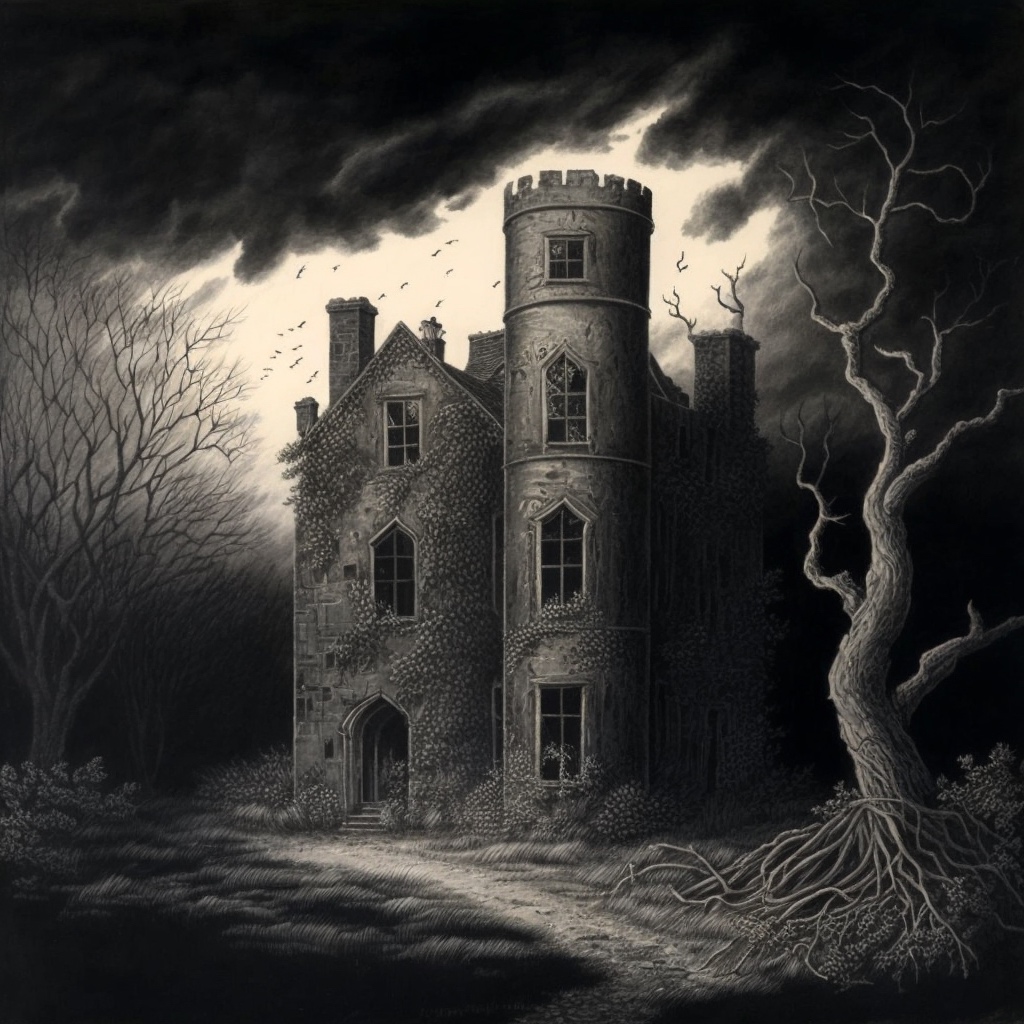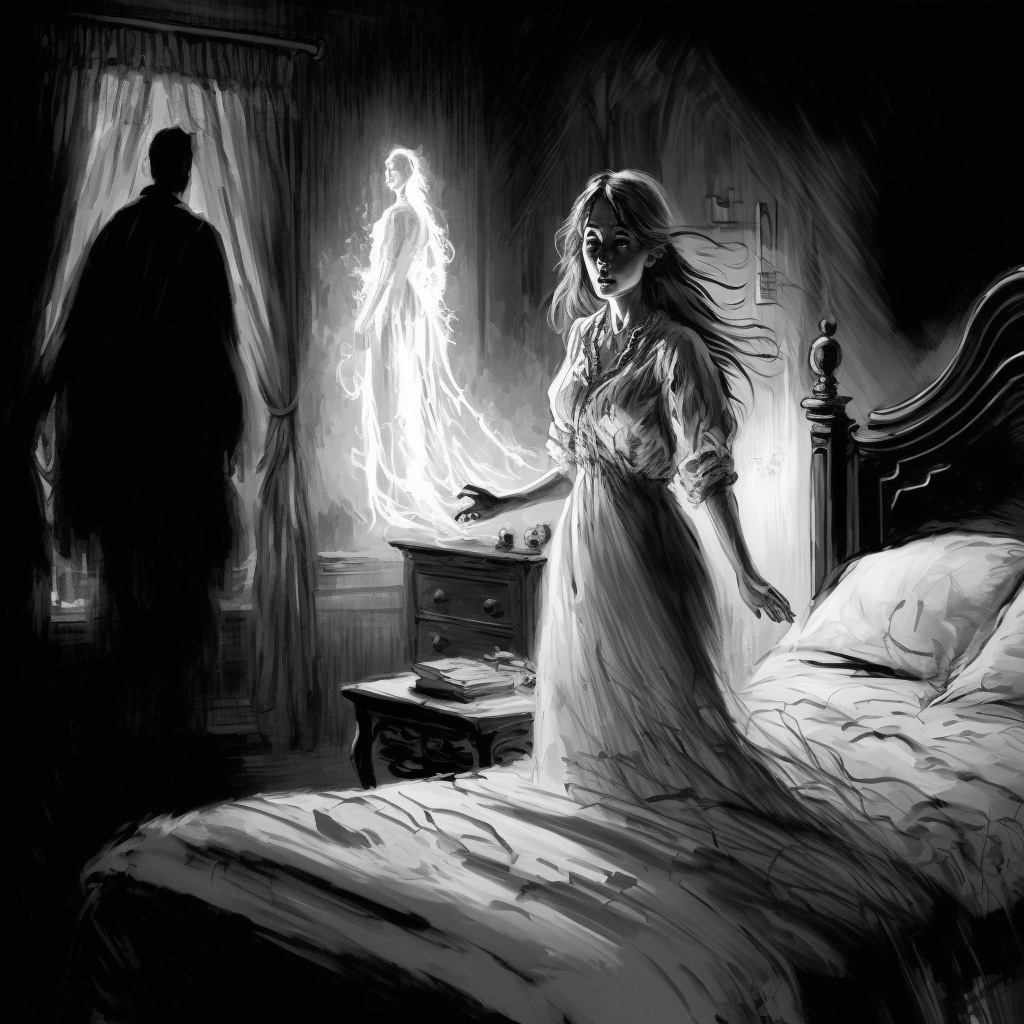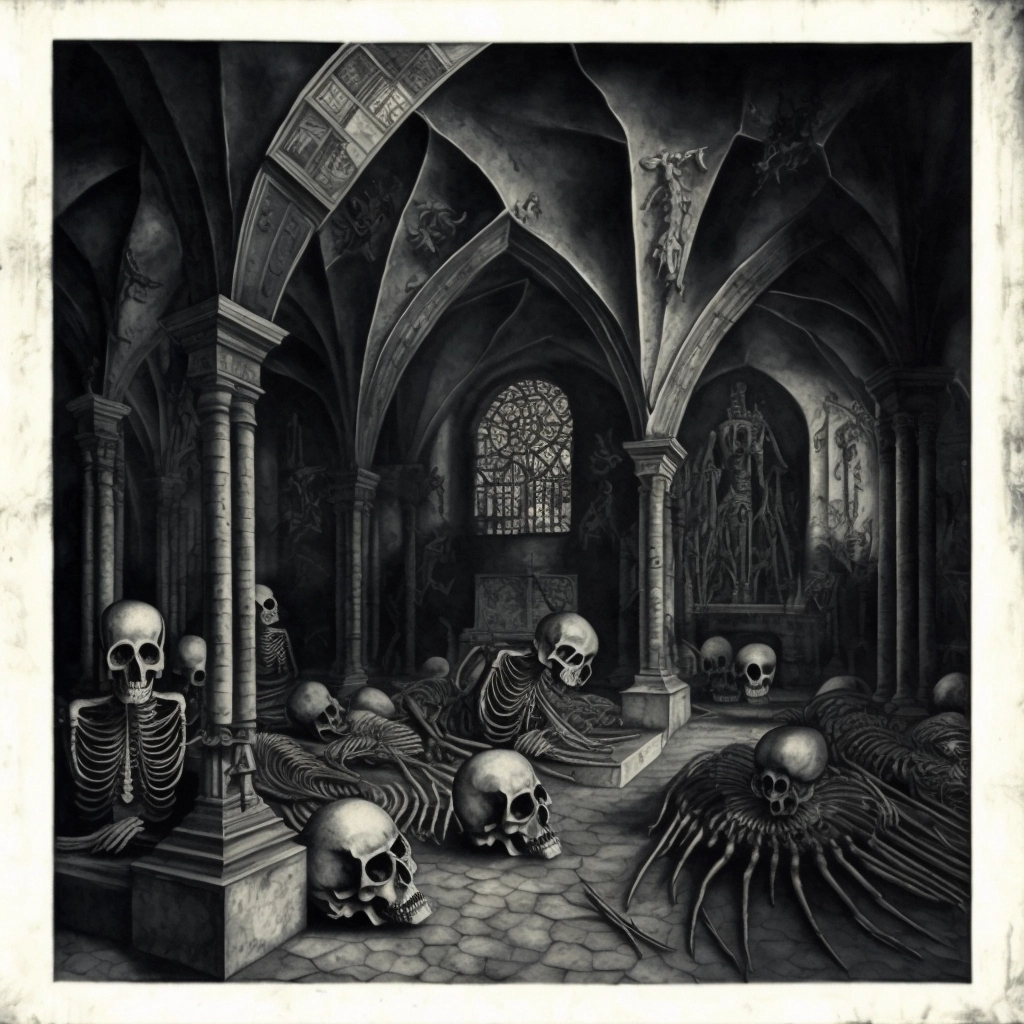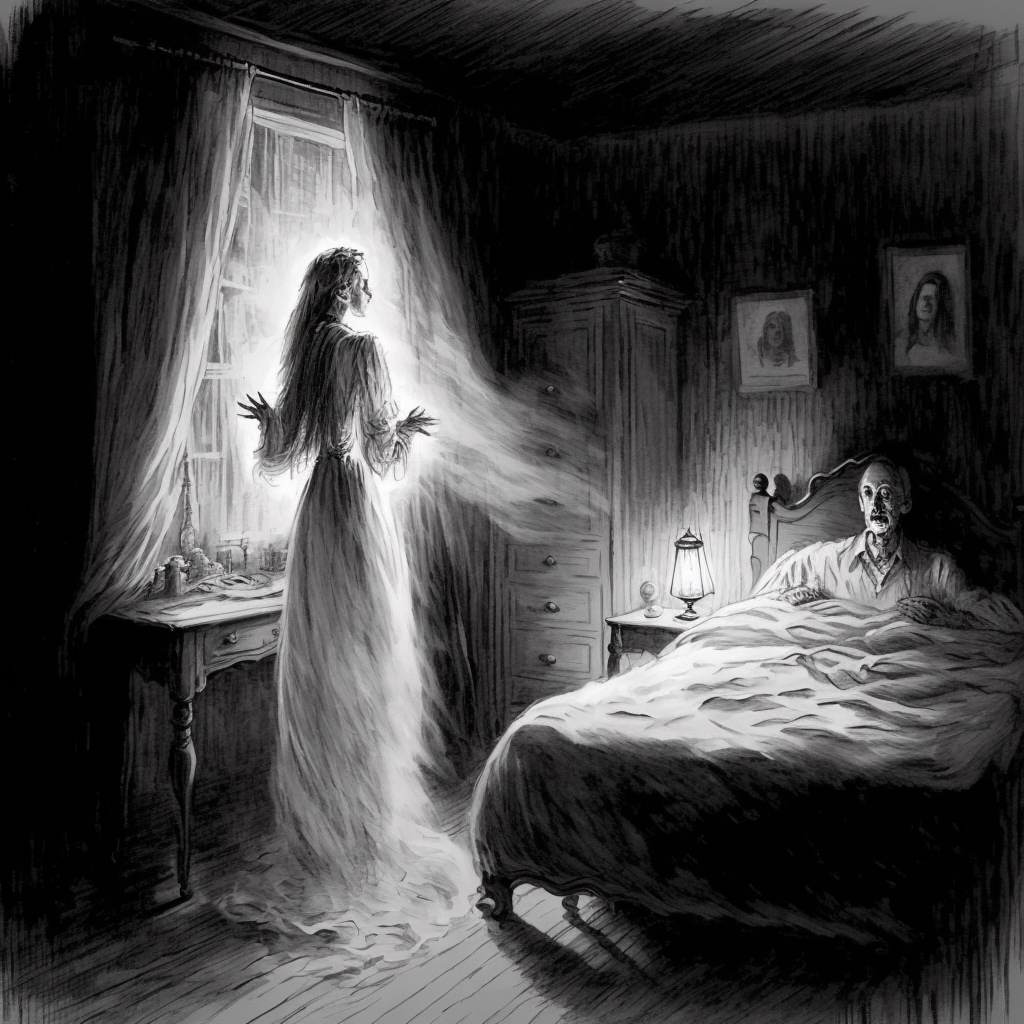
The Creslow Manor Ghost
The Creslow apparition. And this is another story from Glimpses of the Supernatural by Reverend Frederick George Lee, published 1875, in which he collects whole bunches of supernatural stories of varying quality, I’ve got to say, but this is quite a good one, so he says:
“Creslow in Buckinghamshire, like so many old man houses, has its ghost story.
It is said to be the disturbed and restless spirit of a lady who haunts a certain sleeping chamber in the oldest portion of the house. She has been seldom seen, but often heard only too plainly by those who have ventured to sleep in this room or to enter it. After midnight, she appears to come up from the old groined crypt and always enters by the door at the top of the nearest staircase.
After entering, she’s heard to walk about, sometimes in a gentle, stately manner, apparently with a long silk train sweeping the floor. Sometimes her motion is quick and hurried, a silk dress rustling violently, as if she were engaged in a desperate struggle. This chamber, though furnished as a bedroom, is seldom used and is said to have never been entered without trepidation and awe.
Occasionally, however, some persons have been found bold enough to dare the harmless noises of the mysterious intruder, and many other stories current in Buckinghamshire respecting such adventures, the following will suffice as a specimen, and may be depended on as authentic. About the year 1850, a gentleman not many years ago, high Sheriff of the county, who resides some few miles a distance from Creslow, rode over to a dinner party, and as the night became exceedingly dark and rainy, he was urged to stay over the night if he had no objection to sleep in the haunted Chamber. The offer of a bed in such a room, so far from deterring him, induced him at once to accept the invitation.
He was a strong minded man of a powerful frame and undaunted courage, and, like so many others, entertained a sovereign contempt for all haunted chambers, ghosts and apparitions. The room was prepared for him. He would neither have a fire nor a nightlight, but was provided with a box of Lucifers, that he might light a candle if he wished, harming himself in jest with a cutlass and abrasive pistols, he took a serio-comic farewell of the family and entered his formidable dormitory.
In due course, morning dawned, the sun rose, and a most beautiful day succeeded, a very wet and dismal night. The family and their guests assembled in the breakfast room, and every countenance seemed cheered and brightened by the loveliness of the morning. They drew round the table when the host remarked that Mr S, the tenant of the haunted chamber, was absent.
A servant was sent to summon him to breakfast, but he soon returned, saying he had knocked loudly at his door but received no answer, and that a jug of hot water left there was still standing unused. On hearing this, two or three gentlemen ran up to the room, and after knocking and receiving no answer, opened it and entered. It was empty.
Inquiry was made of the servants they had neither seen nor heard anything of him, as he was a county magistrate, some supposed that he had gone to attend the board, which met that morning at an early hour but his horse was still in the stable, so that could not be. While we were at breakfast, however, he came in and gave the following account of his last night’s experiences having entered my room, said he, I locked and bolted both the doors, carefully examined the whole room, and satisfied myself that there was no living creature in it but myself, nor any entrance but those which I had secured. I got into bed, and with a conviction that I should sleep soundly as usual, till six in the morning, was soon lost in a comfortable slumber.
Suddenly I was awakened, and on raising my head to listen, I certainly heard a sound resembling a light, soft tread of a lady’s footstep, accompanied with the rustling as of a silk gown. I sprang out of bed, and having lighted a candle, found that there was nothing either to be seen or heard. I carefully examined the whole room.
I looked under the bed, into the fireplace, up the chimney, and at both the doors which were fastened just as I had left them. I then looked at my watch, and found it was just a few minutes past twelve. As all was now perfectly quiet again, I put out the candle, got into bed, and soon fell asleep.
I was again aroused. The noise was now louder than before. It appeared like the violent rustling of a stiff silk dress.
A second time I sprang out of bed, darted to the spot where the noise was, and tried to grasp the intruder in my arms. My arms met together, but enclosed nothing. The noise passed to another part of the room, and I followed it groping near the floor, to prevent anything passing under my arms.
It was in vain I could feel nothing. The sound died at the doorway to the crypt, and all again was still. I now left the candle burning, though I never sleep comfortably with a light in my room and went to bed again, but certainly felt not a little perplexed at being unable to detect the cause of the noise, nor to account for its cessation when the candle was lighted,
That this gentleman’s experience and as to ghosts he was a skeptic only served to strengthen the old and unbroken tradition of its foundation. Nothing very certain is known. The general facts, however, are commonly received.

Creslow History
Creslow, which is close to Whitchurch and is sometimes called Christlow, is about six and a half miles from Aylesbury.
The name Caersehlaw comes from the Anglo-Saxon language and means “cress hill.” It was documented as Cresselai in the Domesday Book of 1086.
During the time of Edward the Confessor, in 1066, an English woman named Wulfwynn of Creslow. Her son was Edward of Salisbury.
Edward of Salisbury is a justice during the reign of Edward the Confessor and so is an Anglo-Saxon. He became sheriff of Wiltshire perhaps just after 1070 and was in the office by 1081 and kept the role until 1105 when he appears in a list of sherriffs witnessing a charter of Henry I.
He was an important and wealthy man with land in Salisbury in Wiltshire and in Chelsea, just outside London (in those days). His son owned land in Normandy, which was exceptionally unusual for an Anglo-Saxon. He was perhaps of mixed heritage.
After that him, Creslow was held by the descendants of the Earls of Salisbury until 1322.
Thomas Earl of Lancaster married a Salisbury and inherited Creslow. But In 1321, Thomas Earl of Lancaster rose up against the king, but at the Battle of Boroughbridge on March 16, 1322, he was defeated and taken prisoner. was found guilty and the estate taken off him.
We have seen that the church belong to the Knights Templar and after they were suppressed it passed to the Knights Hospitaller until the dissolution of the monasteries between 1536 and 1540, when the church (and the manor?) came into the hands of the crown
After that him, Creslow was held by the descendants of the Earls of Salisbury until 1322.
Thomas Earl of Lancaster married a Salisbury and inherited Creslow. But In 1321, Thomas Earl of Lancaster rose up against the king, but at the Battle of Boroughbridge on March 16, 1322, he was defeated and taken prisoner. was found guilty and the estate taken off him.
In the Victorian era Creslow parish only consisted of one house, a manor house from the 14th century, which was also a farm. On the 1878 map, it simply says: Manor House (Remains Of)
The church in Creslow is also demolished. It dates back to the 13th century, ad was once owned by the Knights Templar and, after they were outlawed, by the Knights Hospitaller (the Order of St John of Jerusalem).
From the 16th century on, people often called the manor and land of Creslow “Creslow Pastures.” This was because sheep and oxen for the royal household were pastured there. The Crown hired a person to take care of these pastures, and that person usually lived in the manor-house.
In 1635, it was given to Cornelius Holland for eighteen years. In 1645, the grant to Holland was extended for another 21 years.
Queen Elizabeth I demolished the parish church, and the building was destroyed by the regicide Cornelius Holland during the English Civil War. It was never rebuilt.
In 1635, it was given to Cornelius Holland for eighteen years. In 1645 (during the Civil War), the grant to Holland was extended for another 21 years.
During the English Civil War, Cornelius Holland was one of the people who tried to stop Charles I and Parliament from making peace in September 1648. In January 1648/9, he was a Commissioner (a judge) at the trial of Charles I. Even though he didn’t sign the king’s death warrant, he was still considered a regicide and had to be killed. His heirs had to give up his property.
He got away. He first went to the Netherlands, where he was lucky enough to avoid being killed. Two other Regicides were not so lucky. He went to Switzerland, which was not Catholic, and got there in September or October 1666. He lived in Lausanne and Vevey (on Lake Geneva) until at least 1669, but he probably died in 1672 or 1674.
In 1673, the manor was given to Lord Clifford for free, and he kept it until his death.
The census numbers for Creslow during the 19th century, which show that the most people lived there in 1891 was 16.
More recently, Creslow was home to an MI6 signals intelligence station that closed in 1998.
The census numbers for Creslow during the 19th century, which show that the most people lived there in 1891 was 16.
Creslow Manor is now used as a luxury event and wedding venue. Part of the estate nearby past the farm, as shown on Google Earth, looks very modern.
Apparently, it operates as a data processing facility and fibre optic hub under the name Creslow Park.

The Building
The parish is located on high ground in the centre of the county, with its highest point at 513 ft. above ordnance datum in the northwest. It slopes down towards the east, separated from Cublington by a stream.
The Manor House, which in 1925 was the residence of Mr. Richard Rowland and a farm for surrounding lands, is a 14th-century house that has undergone alteration and rearrangement, causing damage. The original portions of the house, mostly making up the present building, were built in the first half of the 14th century by John Stretley and consist of a hall, a north wing with offices and kitchen that no longer exists, a south chamber block with a vaulted crypt, and a tower in the southwest.
In the first half of the 17th century, the house was mostly remodeled, with upper floors added to the hall and a new staircase built, likely by Cornelius Holland.
In the 19th century, the north end of the hall was torn down, and the west wall of the hall was rebuilt.
Inside, the hall is now divided by partitions but still has visible original roof trusses with arched braces, central hearth, and soot. The crypt has a quadripartite vault, and there are cellars under the hall block, one with a pointed barrel-vault. The solar block’s top floor was turned into a long gallery during the 17th-century renovation, and some of its fine plaster ceiling still remains, along with other good work from that period, like the oak principal stairs.
The exterior of the house is picturesque, with many gables and chimney-shafts, with the tower at the south-west of the solar block as the most striking feature.
It is three stories tall, built of squared blocks of masonry, with a semi-octagonal stair turret and a large buttress. The walls are crowned with a plain molding, but underneath is a 14th-century parapet with gargoyles.
The east face has a 14th-century window, and the south front has early 17th-century stone-mullioned windows. The west front has 14th-century single-light windows. The stair turret has three rectangular loop lights and a doorway opening onto the roof. The south wall of the solar block has a 14th-century window, and the east end has a gabled stepped slope with a quatrefoiled circular opening. All other features are modern or from the 17th century.
A description of the house circa 1925 appeared in House Description ‘A History of the County of Buckingham’ by William Page;
‘ The Manor House, the residence of Mr. Richard Rowland, who farms the surrounding lands, is an exceptionally interesting example of a 14th-century house, though it has unfortunately suffered a great deal from alteration and rearrangement. The original portions, which comprise the greater part of the present house, are of the first half of the 14th century, and were possibly built by John Stretley, lord of the manor at that time. The plan must have then consisted of a hall placed with its greatest length from north to south, and having a slight projection over the west side of the dais, a wing at the north end containing the offices and kitchen, which has now disappeared, and a chamber block on the south, with a vaulted crypt under its eastern end, and a large tower at the south-west with an octagonal stair turret at its north-west angle; a small wing projecting from the east end of the south wall of the solar block also seems to be of original date……. Adjoining the manor-house on the north-west is the nave of the old parish church. It is about 37 ft. by 19 ft., and has walls of stone rubble with ashlar dressings and a tiled roof. It dates probably from the latter part of the 12th century, but was altered in the 15th century. During Elizabeth’s reign services ceased to be performed, and in 1786 it was used as a dovecot. Shortly afterwards it was adapted to serve its present purpose as a coach-house.‘
Current Use of Creslow Manor
Creslow Manor is now a wedding and event venue. You can book it for your event here:
Creslow Manor,
Creslow,
Aylesbury,
Buckinghamshire.
HP22 4EH
01296 640191
https://www.creslowevents.co.uk/
Silk In England
So who was the lady who rustled in silk? When did silk dresses become common in England, even for the wealthy?
Every English person will tell you that it’s too cold to raise silkworms in England. Even though mulberry bushes, which silkworms need, are easy to grow here, the larvae would not be able to survive the cold and frost of a British winter.
But this country has a long history of making high-quality stockings and parachutes out of imported silk thread. Some towns in England are known for weaving silk, and this beautiful fabric is still made today.
English looms have been used to make fabric from imported thread since the late Middle Ages. The art of throwing silk was perfected in Cheshire (Macclesfield and Congleton), Staffordshire (Leek), and London, where imported bundles of silk were turned into cloth through five steps: winding, cleaning, spinning, doubling, and then throwing.
Silk weaving was talked about as early as the late 15th century, when a law said that silk goods made in England were better than those made elsewhere.
Later, in the 16th and 17th centuries, a large number of Huguenot Protestants moved to England from France. Along with them came a large number of skilled weavers, who brought a lot of knowledge to Spitalfields, Coventry, Canterbury, and other places. Weaver’s houses from the time can still be seen in England. They had large windows in the front and back, which was unusual for the time.
Silk was expensive, but people from all walks of life wore it.

The Creslow Manor Ghost
From the time of the Dissolution of the Monasteries until King Charles II’s time in power, the manor of Creslow belonged to the Crown and was used to graze cattle for the royal household. It was given to Thomas, Lord Clifford of Chudleigh, after the Restoration (1630-73).
The octagonal turret in the west corner and the crypt underneath it are both from the 14th century.
Rev. W. Hastings Kelke wrote in Records of Buckinghamshire (1858) that there was a vault nearby called “the dungeon” that had no windows and held skulls and other human bones that had been dug up near the manor house and church.
Murray’s Handbook for Buckinghamshire, written in 1860, said that the bones were thought to be from prisoners who were kept there.
The Handbook also says that a tunnel led from the cellars to the big pasture. Bones (p. 336) and Secret Passages (p. 336) are both romantic, and Murray does not disappoint: “One of the rooms has a ghost in a silk dress who is said to be Rosamund Clifford.”
It is said that King Henry II’s mistress, “Fair Rosamund,” had a bower built for her in Woodstock, Oxfordshire.
We should remember that King Henry’s dates were 5 March 1133 – 6 July 1189.
She probably became associated in Creslow’s traditions because she had the same last name as Thomas, Lord Clifford, from a different branch of her family.
In the time of Henry II, the land belonged to the Salisbury family and the Cliffords were not associated with the land until 400 years later.
But in Buckinghamshire, people believed in the early 19th century that Henry had built her another place to stay in or near Kingswood. I’m not sure that local belief makes it true.
Not everyone thought Rosamund was Creslow’s ghost. In the 1860s, Chambers’s Book of Days said that the haunted room was one above the crypt that used to be reached by a staircase and had a Gothic door with human heads and grotesque faces. People who slept in this room or went in after midnight often heard the ghost, but they rarely saw it. She always went in through the Gothic door and seemed to come from the crypt or dungeon. Then she would walk around, and her long train would sweep the floor. Sometimes, her silk dress rustled so hard that it sounded like she was in a quarrel or fight.
Because of the ghost, the room was rarely used, and even the servants tried to stay away from it.
Writing in 1902, Allan Fea describes a visit to the Manor House at Creslow in his book Picturesque Old Houses.
‘The gentleman farmer whose family has resided there for some generations kindly took me round, from the vaults up to the roof, where a glorious view may be obtained. The old crypt has a very graceful groined roof. From this crypt a subterranean passage is supposed to run I forget how far, but a couple of miles at least. A newel staircase leads from the crypt to an old room above, which has Early Gothic doors and windows.
Formerly there were rumours current that this room was haunted, but the present resident puts but little faith in such stories, possibly from the fact that the ghost, as in the case of most spiritual séances, only works, or worked, in the dark. The last visitation is said to have happened quite fifty years ago, so the uneasy spirit probably has been successfully laid.
By all accounts, the apparition was a lady who made her entry from the crypt, and for some reason or other, as might be judged from the sound, put her silken gown into violent motion. This naturally suggests the idea of shaking off the beetles and spiders who might have gained a holding in the lower apartment.
Indeed, I might go so far as to affirm that one courageous gentleman, who in the darkness endeavoured to clasp the noise in his arms, actually did get hold of a fat spider; so doubtless my inference is correct, that the lady had very good reasons for the vigorous rustling of her garments upon leaving the lower regions. I forgot to mention the human bones in the crypt. I casually picked up a thigh-bone, and, ruminating upon the possibilities of its past, like Hamlet over Yorick’s skull, I was horrified in looking round to observe the dog who had followed us about the premises was actually begging for it!’
Samuel Lewis’s 1848 book “A Topographical Dictionary of England” had this to say about Creslow around the time of the event:
“The church is desecrated, and the people go to church at Whitchurch.”
The only thing left of the old mansion at Creslow House is a walled tower with a crypt. It used to belong to the Lords de Clifford, but all the records about it have been lost or destroyed. Roman coins made of silver and copper have been found here.
Connection to the Knights Hospitallers
Some sources say that the Knights Hospitallers (Knights of St. John of Jerusalem) owned the Manor House until the Dissolution of the Monasteries. Before that, the Knights Templars owned it until they were put out of business.
In the 1300s, the church at Creslow was one of the things that the priory of St. John of Jerusalem owned. It was run by the Commandery of Hogshaw, which owned Hogshaw Manor and the churches in Ludgershall, Addington, Hogshaw, Cholesbury, and Oving, in addition to the Creslow Church.
The Knights Hospitallers have always owned the property of the Commandery of Hogshaw. It was never given to them by the Knights Templars. They kept the right to put someone in charge of a church living or office, until King Henry VIII’s reign and the Dissolution of the Monasteries.
A History of the County of Buckingham says,
“It went back to the Crown at the Dissolution, and Philip and Mary gave the last gift to the church in 1554.”
Elizabeth got rid of the rectory when she became queen because the church was no longer needed since the number of people had gone down. The building was destroyed in the end, and now the people of the parish go to the church in Whitchurch.



